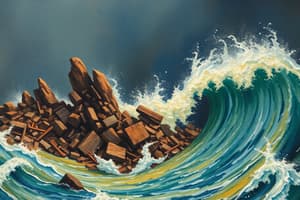Podcast
Questions and Answers
What causes an earthquake?
What causes an earthquake?
- Sudden and violent shaking of the ground
- The movement of tectonic plates
- Mechanical waves traveling through the layers of rock
- The release of energy within the earth's crust (correct)
How do scientists measure the behavior of earthquake waves?
How do scientists measure the behavior of earthquake waves?
- Analyzing the movement of tectonic plates
- Monitoring the convection within the mantle
- Recording the seismic waves with satellites
- Using delicate instruments called seismographs (correct)
Where do most earthquakes occur?
Where do most earthquakes occur?
- On faults within the earth
- Underwater in the oceanic crust
- Primarily in the Earth's mantle
- At the boundaries between different tectonic plates (correct)
What primarily drives the motion of tectonic plates?
What primarily drives the motion of tectonic plates?
Where can earthquakes occur on the surface of the Earth?
Where can earthquakes occur on the surface of the Earth?
What are tsunamis caused by?
What are tsunamis caused by?
What are the three main parts of an earthquake?
What are the three main parts of an earthquake?
What is another term for the focus of an earthquake?
What is another term for the focus of an earthquake?
What are the four types of seismic waves?
What are the four types of seismic waves?
What are the majority of earthquakes caused by?
What are the majority of earthquakes caused by?
Flashcards
Cause of Earthquakes?
Cause of Earthquakes?
The release of energy within the Earth's crust, often due to tectonic plate movement.
Seismographs
Seismographs
Delicate instruments used to measure and record the behavior of earthquake waves.
Location of most earthquakes
Location of most earthquakes
Most earthquakes occur at the boundaries between different tectonic plates.
Driving force of tectonic plates
Driving force of tectonic plates
Signup and view all the flashcards
Earthquake locations
Earthquake locations
Signup and view all the flashcards
Cause of tsunamis
Cause of tsunamis
Signup and view all the flashcards
Main parts of an earthquake
Main parts of an earthquake
Signup and view all the flashcards
Hypocenter
Hypocenter
Signup and view all the flashcards
Types of seismic waves
Types of seismic waves
Signup and view all the flashcards
Primary cause of earthquakes
Primary cause of earthquakes
Signup and view all the flashcards
Study Notes
Understanding Earthquakes and Tsunamis
- Tsunamis are not tidal waves, they are large water waves caused by underwater earthquakes, reaching up to 100 feet in height, and causing destruction on land.
- Earthquakes can occur on intraplate faults, not just on tectonic plate boundaries, such as the New Madrid Fault in the United States.
- An earthquake consists of three main parts: the focus, seismic waves, and the fault along which the earthquake occurs.
- The focus is the origin of the earthquake, seismic waves are mechanical energy propagation through the earth's layers, and the fault line is where the mechanical energy is released.
- The epicenter is the surface location directly above the focus of the earthquake, and the hypocenter is another term for the focus.
- There are four types of seismic waves: primary (P-) waves, secondary (S-) waves, Rayleigh waves, and Love waves, each with distinct properties and behaviors.
- Faults are cracks in the earth where two sections of rock can move relative to each other, and there are three main types: thrust or reverse faults, normal faults, and strike-slip faults, each with different motion.
- The majority of earthquakes occur along tectonic boundaries and faults in the earth's crust, with tectonic earthquakes caused by tectonic plates moving against each other along a fault.
- Tectonic earthquakes occur in five stages: elastic build-up, dilatancy, influx of water, earthquake, and aftershocks, as identified by geologist Henry Fielding Reid.
- There are four types of earthquakes: tectonic, volcanic, collapse, and explosion, each triggered by different events.
- Tectonic earthquakes are caused by sliding along a fault or tectonic boundary, volcanic earthquakes are triggered by nearby volcanic activity, collapse earthquakes occur in underground caves or mines, and explosion earthquakes are caused by detonation of a nuclear or chemical bomb.
Studying That Suits You
Use AI to generate personalized quizzes and flashcards to suit your learning preferences.




